Household Recipes
Perfume, Pot Cleaner, Lotion, or Lip Balm: Make Them Naturally
Most Americans are accustomed to going to the drugstore for their cosmetics and medicines, to the supermarket for their kitchen cleansers and pesticides, and to the hardware store for their paints and glue. But it was not very long ago that all these products, and most other necessities of life, had to be made in the home.
The making and using of simple recipes and remedies today provide an excellent way to save money and at the same time to learn old-time lore that was once common knowledge. In addition, when you prepare a household recipe yourself, you have the satisfaction and reassurance of knowing that your product contains only natural substances. Of course, no recipe or remedy should replace the advice and services of a doctor; and since an allergic reaction is always possible, you should be cautious when first using any recipe.
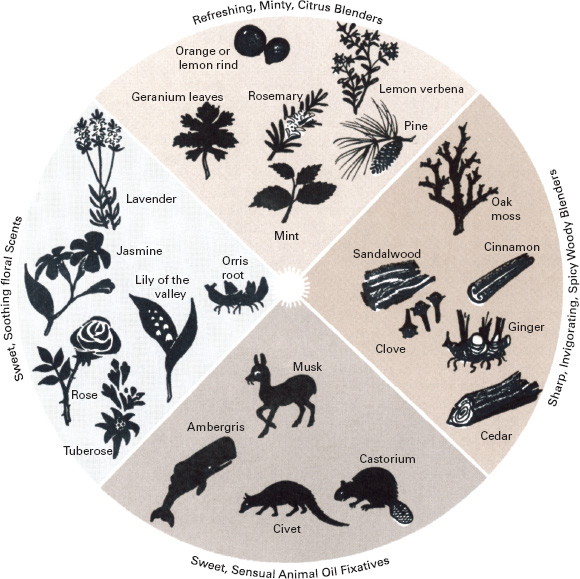
An aromatic mixture must be composed carefully to achieve a harmonious blend. Either choose one ingredient for the primary scent and add a small amount of blender from the same or neighboring category, or mix equal amounts of several similar ingredients.
Almost any fragrant flower or herb can be used for moist potpourri. Flowers that retain their aromas when dry should be the basis for dried flower potpourris. Lavender and rose—especially old-fashioned rose varieties such as damask and cabbage—are traditional. For color, use hollyhock, nasturtium, marigold, aster, and the everlastings. In enfleurage use highly scented flowers such as jasmine, lily of the valley, orange blossom, and rose. Mint, citrus peel, woods, and spices are good secondary blending materials for both potpourris and enfleurage.
Fixatives are needed to hold a scent. Animal-oil fixatives are best, but orris root, oak moss, gum benzoin, and cedar and sandalwood oils can be used.
Flowers in History
Flowers and other aromatic substances hold an important place in folklore and tradition. Before the discovery of bacteria and viruses, when diseases were thought to be transmitted through bad odors, flowers and scents were used to purify the air and ward off illness. Well-to-do members of society carried orange pomanders to hold to their noses whenever they encountered a bad odor.
In religious ceremonies incense made of herbs and resins has been used since Egyptian times, when it was believed to carry human souls to heaven. In classical times incense was considered to be one of the best offerings to the gods. In the Middle Ages a practicing “witch” would burn more sinister ingredients to summon devils or conjure up a spirit, and young girls would burn incense at night to ward off the advances of lecherous incubi. Incense has been used in Hindu monasteries as an aid to meditation and is still used in various rituals in the Roman Catholic Church.
Over the centuries, various flowers took on special meanings. A single rose, for example, represented silence, and roses were often sculpted on dining room ceilings to indicate that whatever was said there—particularly if the wine had been flowing freely—was sub rosa (“under the rose”) and not to be repeated. Roses also became emblems for love: a white bridal rose signified happy love, a yellow rose indicated waning affection, and a deep red rose stood for bashfulness. Eventually nearly every flower and herb acquired a meaning—daisy for innocence, rosemary for remembrance, and so on—so that a lover could convey his feelings by sending a bouquet of the appropriate flowers. An inverted flower indicated the opposite of the normal meaning.
Flowers and herbs have been used since time immemorial to sweeten the air and perfume the body. In the Victorian era housewives placed bowls of potpourri around the house much as we use room deodorants today. The name potpourri, which means “rotten pot” in French, derives from the fact that old-time potpourris were prepared by the moist method, in which the ingredients were allowed to stew, or rot, for months to develop a powerful, lasting fragrance. Nowadays potpourri is usually prepared by the simpler dry method.
Master perfumers today use a tremendous array of bottled fragrances (most of them synthetic) to create their perfumes. Their finished fragrances can be likened to pieces of music, with a main scent (the theme) and blending fragrances (the variations) that accent the theme and give it richness and staying power. The same principle—a symphony of aromas—applies to homemade potpourris, flower perfumes, and other fragrant concoctions. With a careful blend of ingredients, plus a little fixative to ensure the gradual release of fragrance over a long time span, you will be able to make your own natural, sweet-smelling scents.
Potpourri: Putting Summer in a Jar
The fragrances of summer can be captured for the winter with a potpourri—a sweet-smelling blend of preserved flower petals and other aromatic plant parts. There are two types of potpourri: dry and moist. Dry potpourri is easier to make and more decorative, since it preserves the form and color of the flowers. Moist potpourri bleaches color but creates a stronger fragrance.
To make dry potpourri, gather the flowers just after they have opened, as soon as the dew dries off in the morning. Pluck the petals from each flower and spread them out on newspapers or a window screen made of fiberglass or other nonmetallic screening. A few flowers, particularly rosebuds, can be dried whole to add visual interest to the finished potpourri. Place the screens in a warm, dry place away from drafts and direct sunlight. Shift the petals every day or two to speed the drying.
When the petals are completely dry and crisp, select a mixture that produces an agreeable blend of scents. Add several aromatic herbs, some bark or spices, a little aromatic oil (see p.338), and a drop or two of fixative (about 1 teaspoon for each 2 cups of petals). Let the mixture age in a covered crock for four to six weeks before setting the potpourri out in smaller jars and bowls. Cover the containers when their scent is not needed; this will preserve the fragrance longer. The scent can be revived from time to time with a few drops of aromatic oil or good brandy. Dry potpourri can also be converted into a sachet by grinding or crumbling the blended ingredients into a coarse powder, then sewing them into a small bag made of tightly woven fabric.
Enfleurage: Extracting Perfume From Flowers
Genuine flower perfume is expensive and hard to come by. However, by using the technique known as enfleurage, you can extract the scents of flowers yourself.
Melt enough lard or other completely odor-free fat to cover the bottoms of about 10 large, shallow plates to a depth of ½ inch. The pairs of plates must be matched so that one can be placed upside down on another with almost no gaps at the rim. Allow the lard to solidify, then score it in a crisscross pattern. Fill the space between each pair of plates with the petals of a highly scented flower, and add a little spice, herbs, or citrus peel to accent the scent further. Be careful not to let any other plant parts drop into the plates; they may introduce fungi that will spoil the perfume. Next, seal the plates together with tape and set them aside. After one or two days remove the wilted petals and repeat the process with fresh, unblemished petals. When you have made seven or eight changes of flowers, cut up the lard, half fill several small, sterile glass bottles with it, and top off with alcohol. (Pure ethyl alcohol is best, but rubbing alcohol will do.) Close the bottles tightly, shake them well, and put them in a dark place for 8 to 12 weeks. During this time you should shake each bottle periodically—once each day if possible.
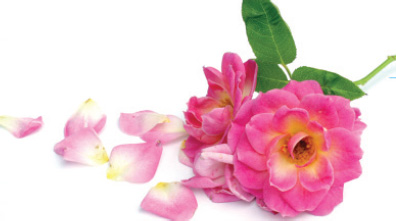
Aroma of fresh flowers can be preserved when absorbed by lard and held by alcohol.
When the time period is up, pour the perfume into clean bottles using a funnel with a piece of muslin in it to strain out the fat globules. Now add a very small quantity of fixative oil (about two drops per ¼ cup of perfume) as a preservative.
For moist potpourri, let your newly collected petals dry until they are leathery—about two to three days. Load a large wide-mouthed crock with alternating layers of petals and noniodized salt. When the crock is two-thirds full, place a weighted plate on top to compress the petals. Stir the pot every few days, breaking up any crust that forms on the top. After two weeks or more have gone by (the longer the potpourri is left standing, the stronger and more lasting the fragrance will be), mix the petals thoroughly and add spices, roots, and aromatic and fixative oils. (The choice of additives depends on the potpourri's basic scent and your own taste; experiment with different combinations.) Mix again and allow to mature for another two weeks. The scent will be a little raw at first but should soon mellow.
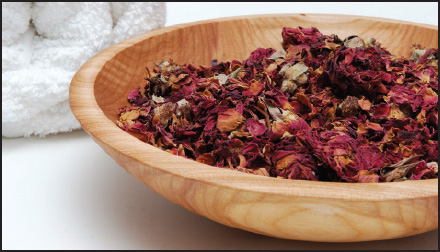
Open bowls or jars are perfect for holding dry potpourri. Moist potpourri is traditionally kept in china jars with pierced lids.
Four flower recipes
Aromatic rose beads. Pick 30 to 40 blooms on a dry day and cut the petals very fine. Place in a pot and barely cover with water. (If you want dark red beads, use an iron pot.) Heat gently for an hour, adding water as necessary. A day later heat again. Then strain the pulp and roll it into beads. Thread the beads onto fine string with a heated needle and dry for a day or two, moving the beads occasionally. When you wear the beads around your neck, your body warmth will cause them to release a sweet rose scent.
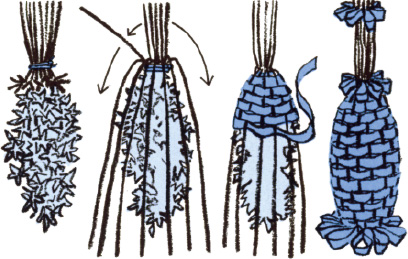
Lavenderette. By enclosing lavender flowers within a basket of their own stems, the fragrant blossoms are prevented from shedding. Tie an odd number of fresh lavender spikes together just above the flowers, bend the stems down, and weave ribbon to form basket. Cinch with bows at top and bottom. Place on bed, table, or among clothing.
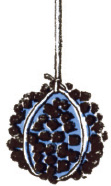
Orange or lemon pomander. Take a fresh, unflawed fruit with a thick rind and push in cloves over the whole surface; then roll the studded fruit in a mixture of cinnamon, nutmeg, and orris root plus a few drops of lemon or orange oil. Wrap in tissue paper and dry in a warm place for a few weeks. Pomanders sweeten the air and also help to repel insects.
Crystallized flowers. Spread fresh violets, lilacs, or mimosa on a sheet of wax paper and dampen with a solution of 2 oz. gum arabic (available at specialty apothecaries) in a cup of water. Let the flowers dry for a day, then place them in ovenproof glass dishes. Mix 1 cup of water with 2 cups of sugar and heat to 250°F. Add food coloring, skim off surface froth, and pour the mixture over the flowers. After 24 hours place the uncovered dishes in a very slow oven until the flowers are dry. Crystallized flowers make bright and colorful decorations on frosted cakes and creamy desserts.
The Ancient Science Of Herbal Medicine
According to an Irish folk legend, the medicinal herbs sprang from the buried body of a fallen hero. The curative powers of each herb applied to the particular region of the hero's anatomy from which it grew. The legend goes on to say, however, that through carelessness the herbs were mixed up and that mankind has been trying to sort them out ever since.
Fanciful though the tale may be, there is no doubt that centuries of effort and experimentation have been expended, on the scientific level as well as the folk level, in trying to determine the efficacy of herbs in treating sicknesses. Many of the successes are well-known. Quinine, digitalis, rauwolfia, and the vitamins were all derived from botanicals. Even today, with our ability to synthesize so many drugs, about 40 percent of our pharmaceuticals are obtained from natural sources.
In America herbal medicine began with the Indians. They knew how to treat scurvy centuries before the discovery of vitamin C, and during the Indian Wars there were dozens of well-documented reports of their ability to heal gravely wounded warriors. Their medical reputation was so great that they sometimes served as doctors in isolated frontier areas. Indian lore was particularly important to the early settlers, since they were unfamiliar with New World plants and the traditional European herbs had not yet been introduced.
Many herbal remedies are safe and may help ease minor ailments. However, never substitute one for the advice of a doctor, and do not attempt self-medication without a doctor's approval.
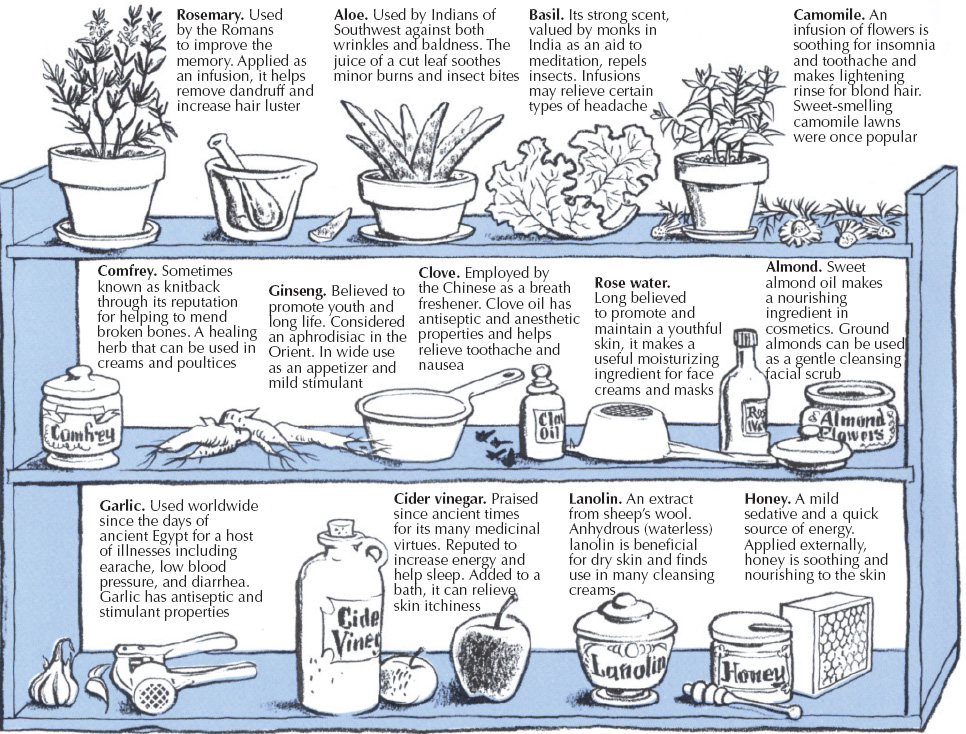
Herbs should be stored in a cool, dark place in airtight jars. When storing or preparing herbs, use china, glass, or unchipped enamel utensils. Avoid nonstick pans and metal, particularly aluminum. The shelf display above contains a few of the most useful ingredients for home remedies and cosmetics. Other valuable herbs include thyme, marjoram, tarragon, and peppermint.
Obtaining Herbs and Preparing Them for Use
Growing your own herbs is the best way to obtain ingredients for herbal mixtures, since the effectiveness of most herbs is highest when the leaves are fresh. You can collect herbs in the wild, but be careful to identify them correctly; many wild plants are quite poisonous. In addition, you should be sure the plant you pick is not a protected species and has not been sprayed. Herbs that are available commercially are usually in dried form. Health-food stores stock many of the standard herbs, or you can order less common herbs from specialist companies. (For information on growing and harvesting herbs, see Herb Gardens, pp.151–153.)
There are any number of traditional ways to prepare herbs for medicinal and other purposes. The most useful are infusions, decoctions, ointments, and oils.
Infusions. An infusion is a strong tea. To make one, pour 1 pint of boiling water over 2 tablespoons of dried herbs. Steep for 10 minutes if the infusion is to be used internally, three hours if it is to be used externally.
Decoctions. Simmer 2 tablespoons of dried herbs in 1 pint of water in a covered pan for 5 to 10 minutes.
Ointments. Mix one part of powdered herbs with four parts of heated lard or other fat and stir thoroughly. Add a few drops of tincture of benzoin as a preservative.
Aromatic oils. Steep fresh flower petals or other aromatic substances in a pure, odor-free oil for one to two days, then discard the petals, and replace them with a new batch. Keep repeating this procedure until the aroma of the oil becomes as potent as that of the flowers themselves—seven or eight times should be enough.
Infusions and decoctions should be stored in a refrigerator and used within three days. Ointments and oils should be stored in a cool, dark place and will last for several months. Certain other herbal preparations, such as tinctures, elixirs, and spirits, are made with pure ethyl alcohol and will keep indefinitely.
Coughs and colds
Soothing cranberry soup. Heat 1 cup of cranberries in 2 cups of water until the skins pop open. Strain and add honey to taste. Heat almost to boiling and remove from heat. Mix 1 tbsp. of potato starch in 2 tbsp. cold water and add slowly to the cranberry juice while stirring vigorously. Bring pot to the boil and continue to stir until the mixture thickens and becomes a little transparent. Serve warm with sugar and cream. This traditional Finnish recipe for colds makes a delicious dessert and at the same time supplies plenty of vitamins B and C.
Sore throat infusions. Drink infusions of comfrey root, camomile, or rosemary with honey and lemon. A cup of warm water water 2 tsp. vinegar can also help.
Herbs for smokers. Chew camomile flowers when you feel the desire to smoke. Camomile is reputed to alleviate the need for tobacco. If the urge to smoke becomes overpowering, try an herb recipe instead of tobacco: mix 1 ounce each of red clover tops and coltsfoot with a pinch each of lavender, yerba santa, and rosemary. Adjust the mixture to suit your personal taste. Crumble the dried mixture to make fine tobacco-sized shreds and roll your own cigarettes.
Glycerine-lemon cough syrup. Heat a lemon by boiling it in water for 10 minutes or roasting it in front of the fire. Cut open and squeeze out the juice, then add 2 tbsp. each of glycerine and honey. Take a teaspoonful at intervals whenever needed.
Headaches and nerves
Peppermint tea for mild depression. Drink a cup of peppermint or papaya mint tea and do something active such as jogging, hiking, weeding the garden, or playing tennis.
For nerves. Drink camomile tea or just a glass of milk. Camomile is very soothing. It can also relieve the pain of a toothache.
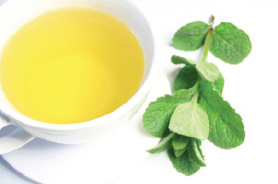
For headaches. Try to counteract the cause. If you have been in the sun, move into the shade and put a damp, cool cloth on your forehead. If you are tired, it may help to eat something to restore your energy or to move away from what you are doing, get some fresh air, and relax. It has been suggested recently that vigorous exercise may alleviate migraine attacks. Even at nighttime you can try jogging in place. For a soothing headache sachet put 4 tbsp. each of dried lavender, marjoram, betony, rose leaf, and rose petals, plus a few cloves, in a sachet. Whenever you have a headache, hold the sachet to your nose and breathe in its scent.
Fatigue and sore feet
Honey-vinegar energizer. A popular recipe for increased energy is 2 tsp. vinegar and 2 tsp. honey in a cup of water. Drink once a day for best results.
Bathing in vinegar. If the natural acidity of the skin has been reduced by too much highly alkaline soap, you can add vinegar or lemon to the bath water to restore the acidity. This may relieve skin itchiness and is reputed to increase your energy. (For other refreshing and soothing herbal baths, see p.341.)
Witch hazel for aching muscles and backs. Soothe tired or sore muscles by massaging gently but firmly with a mixture of 1 cup of witch hazel extract and ¼ cup of rubbing alcohol.
Lavender footbath. Bathing the feet in warm water to which a few drops of lavender oil have been added is said to provide quick relief from foot fatigue.
Walker's remedy for foot fatigue. When suffering from foot fatigue on a long walk in the country, pick some ferns and stuff these into your boots. This provides quick, refreshing relief for tired or sore feet.
Athlete's foot vinegar bath. Vinegar is reputed to help by restoring the acid antibacterial surface of the skin. Steep 1 oz. each of sage and agrimony in hot apple cider vinegar. As soon as the vinegar has cooled sufficiently, place the affected foot in it. Soak for 30 minutes and repeat three times daily. Give the affected foot as much fresh air as possible. Bathing the foot three times a day in water as cold as the foot can stand is also said to help destroy the athlete's foot fungus.
Indigestion and stomach problems
Herbal teas and fruit for indigestion. Some Indian tribes drank mint tea for indigestion. A tea of peppermint or papaya mint tea may help to settle an uncomfortable stomach. Clove tea is held to be useful for allaying more acute cases of nausea. To stimulate the digestive juices, eat a dried fruit or drink some fruit juice as an appetizer before eating a meal.
Soda drink for acid stomach. Mix ½ tsp. baking soda and a few drops of lemon juice in ½ cup warm water and drink immediately. If your symptoms include vomiting, omit lemon juice from the mixture and rinse out your mouth with some of the soda drink before slowly sipping the remainder of the drink.
Garlic seasoning for intestinal infections. Garlic is an old and much used aid for a wide variety of intestinal disorders. It is also an effective stimulant for digestion. Include a clove or two of garlic in your cooking when you are troubled with minor stomach upset. To minimize the smell of garlic on your breath, eat a few sprigs of fresh parsley after eating garlic.
For gas and hiccups. After eating any meal that tends to cause stomach gas, chew candied ginger, fennel, caraway, or dill seeds. For hiccups eat a teaspoon of peanut butter.
Burns, insect bites, and skin irritation
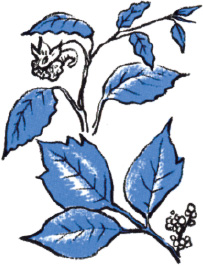
Jewelweed for poison ivy. Indians crushed the leaves and stems of jewelweed, a variety of impatiens, also known as touch-me-not, to relieve the itch and rash caused by poison ivy, poison oak, and poison sumac. Jewelweed often grows near poison ivy, a fortunate coincidence since it is most effective when applied soon after contact. Drinking milk and eating fruits high in vitamin C also helps, and it is always good practice to wash affected areas very thoroughly with cold water and soap as quickly as possible after contacting poison ivy.
Some pleasant chapped-lip balms. Add a few drops of rose water to 1 tbsp. honey and apply to the lips or hands as often as necessary. Honey attracts water and will provide moisture for dry skin. Both honey and rose water are said to have healing properties that help new skin grow. In addition, a mixture of glycerine and rose water is a good moisturizer for lips that are chapped
Bathing in tea for sunburn. Drop two or three tea bags into the water near the tap while the bath is filling. Tannic acid in the tea will help to take the heat from your burn. Alternatively, a strong solution of tea or even a wet tea bag can be dabbed over the affected parts. A decoction of comfrey root added to your bath will also provide relief.
Two simple sunburn lotions. Mix 2 tbsp. vinegar in ½ cup water, or mix equal parts of vinegar and olive or vegetable oil.
An herbal lotion for minor burns. Crush together 2 tbsp. each of marshmallow and comfrey root and heat gently in mixture of 1 cup olive oil and 1 cup wine for 30 minutes. (The wine takes away any burned odor.) Cool and strain. Marshmallow and comfrey are reputed to have excellent skin healing properties.
Aloe remedy for minor burns and insect bites. Break off the largest leaf of an aloe plant and rub the jellylike sap over the burn or bite. The leaf can be wrapped and stored in the refrigerator. It can also be used for minor skin irritations and poison ivy rash.
Caution
Any natural or synthetic substance may cause an allergic reaction in certain people. If you are not sure of a substance, test a minute quantity and wait for up to three days to check for a reaction. Herbal remedies should only be prepared where identification of the plants is certain. Apparently unimportant symptoms may be caused by a serious illness for which a doctor's advice should be sought. Consult a doctor for any serious or persistent complaint.
Natural Cosmetics From the Kitchen
Unlike commercial beauty aids, homemade cosmetics take a bit of time and trouble to prepare and will generally spoil more quickly. However, what is lost in convenience is gained back in other ways: you save money, you are free to experiment with different ingredients to find ones that suit you best, and you know that the ingredients used are fresh and natural.
When making cosmetics at home, be sure that your equipment is absolutely clean. For instructions on preparing herbs, see page 338. To avoid the possibility of an allergic reaction, test a small quantity of any unfamiliar substance on the underside of your arm, and wait 24 to 48 hours to see if a rash develops.
The health of your complexion is the product of many factors including your diet, your age, the amount of exercise you get, and your sleeping habits. Factors that can upset the skin's balance include tension, lack of moisture in the air, overexposure to the sun, and too much of the wrong foods. Although some complexion problems require a doctor's care and others are not easily correctible, there are many simple topical treatments you can make yourself to cleanse, stimulate, and nourish the skin, and help preserve its youthful bloom. The health of the hair is also affected by diet. The condition and texture of the hair is generally improved by taking supplements of vitamins A and D and eating a teaspoon of brewer's yeast daily.
Fruits and Vegetables for Every Skin Type

Feeding the face. Any of these fruits and vegetables can be applied directly to the face; for example, a slice of tomato or cucumber can be used as a simple cleanser. Fruits and vegetables can also be blended and combined with one or more binders to make a complete natural facial to nourish and stimulate your skin. For dry skin, use lanolin, sour cream, honey, or egg yolk as a binder. If possible, add a few drops of liquid lecithin as a moisturizer. For oily skin, yogurt and egg white make drying binders. People with normal skin can use binders from either group and whole eggs and whole milk as well. Before using a mask, thoroughly cleanse your face. Smooth the mask on gently, avoiding the area immediately around the eyes. Rinse off after 30 minutes or as soon as the mask dries. First use warm water and a clean facecloth, then splash with cool water to close the pores. Rinse off the mask immediately if there is any irritation.
For a peaches-and-cream complexion. Blend one ripe peach with enough heavy cream to make a soft cream, and massage into the skin once daily. Keep the mixture under refrigeration. This stimulating, rich moisturizer should help your skin achieve a legendary, soft peaches-and-cream complexion.
Brewer's yeast face mask. Yeast can brighten a sallow complexion (it is rich in B-complex vitamins, which improve blood circulation). Mix yeast powder with a little water to make a soft paste and smooth over the face, avoiding the eyes. Allow to dry before rinsing off with warm water. For best results use the mask once or twice a week and take a few teaspoons of brewer's yeast daily in orange juice or milk. This mask is also beneficial for oily and dry skins, as vitamin B helps to regularize the secretion of skin sebum. Do not use this mask just before going out; it may bring skin impurities to the surface temporarily. If you have a dry complexion, add a tablespoon of wheat germ oil or an egg yolk.
A deep-cleansing clay mask. This mask will cleanse the skin and leave it soft and glowing. Melt ¼ oz. beeswax with 2 oz. lanolin in a double boiler, then add ½ cup rose water while stirring constantly. Remove from heat and work in 8 oz. of fuller's earth. For a simple cleansing mask for oily skin, mix a little fuller's earth with water to a milky consistency, smooth over the skin, and wash off after 15 minutes. This mask stimulates circulation but has a drying action and should not be used too frequently. Apply a light moisturizer after rinsing off the mask.
Papaya peeler for flaky skin. When the weather changes, some people suffer from a flaky complexion. An application of papaya quickly removes the dead flaky skin. Smooth the pulp of a fresh papaya over your face, wipe off the papaya with a facecloth after a minute or two, and splash cool water over your skin to close the pores. You may need to apply a moisturizer afterward, since papaya is a drying agent. For a milder peeler, steep a bag of papaya mint tea in half a cup of boiling water and apply with a facecloth while hot. Rinse off as above.
Mint and ice summer freshener. Blend a few sprigs of mint with finely crushed ice and apply as a quick freshener that will not dehydrate the skin. For a moisturizer rich in vitamins A, B, and C, blend ripe cantaloupe with a few mint sprigs.
Mayonnaise skin food. Simple mayonnaise with eggs, vegetable oil, and vinegar—but no salt—provides a handy blend of several useful skin nutrients. Use your own recipe or buy a good salt-free mayonnaise and massage into the skin as a night cream.
Comfrey and almond oil for wrinkles. With the passing years, the fatty tissue under the skin grows thinner, leaving the skin loose. This condition, together with the reduced elasticity of the skin, contributes to the formation of face lines and wrinkles. Comfrey is reputed to help preserve the youthfulness and elasticity of the skin. Add 1 tbsp. of an infusion of the leaves or 1 tbsp. of a decoction of the roots to a facial mask, or blend into milk or simple cold cream and apply to the skin for several minutes. Almond oil wrinkle cream is a rich moisturizer that boosts the water-holding capacity of the skin and helps plump out wrinkled areas. Melt 1 tbsp. of lanolin with 2 tsp. sweet almond oil in a double boiler. Add 2 tsp. water and allow the mixture to cool, then add in 2 tsp. cod liver oil.
Note: To help delay the formation of wrinkles, apply facial creams and masks very gently. This will preserve the cushion of fatty tissue and avoid stretching the surface skin.
Shampoos and rinses
Whole egg shampoo for dry hair. Beat two eggs until frothy and massage well into scalp. Leave on for a few minutes and rinse off with warm water. (Hot water will cause the eggs to congeal.) To cut the film left by a real egg shampoo, add 2 to 3 tbsp. vinegar to the rinse water if your hair is dark or the juice of half a lemon if your hair is fair.
Rum and egg shampoo for oily hair. Beat together three eggs, ¾ cup rum, and ¾ cup rose water and massage thoroughly into scalp and hair. Rinse with vinegar or beer if your hair is dark or the juice of half a lemon if your hair is fair.
Mayonnaise conditioner. After shampooing, apply any good quality mayonnaise as an excellent hair and scalp conditioner. Massage thoroughly. Leave for ½ hour and rinse off with a rosemary infusion or lemon or vinegar solution.
Rhubarb root golden hair coloring. This is a fairly strong dye that can create a more golden hair color for persons whose hair is blondish or light brown. Simmer 3 tbsp. of rhubarb root in 2 cups of water for 15 minutes, set aside overnight, and strain. Test on a few strands to determine the effect, then pour through the hair as for camomile rinse.
Sage infusions for darkening gray hair. Make a strong infusion of sage (½ cup of dried sage per cup of boiling water) and add to your shampoo or apply to the hair with a wad of cotton after you have shampooed and rinsed your hair. To build up a long-lasting color, mix a cup of sage infusion with a cup of bay rum and ½ oz. glycerine and apply to the hair, particularly the roots, each night until you achieve the color you want.
Rosemary as a versatile hair aid. Add an infusion of rosemary to the final rinse after a shampoo to prevent oiliness and give sheen to dark hair. A rosemary rinse also makes hair more manageable and easy to set and is said to help control dandruff.
Highlighting with henna. Henna is a strong vegetable dye that will produce different results on different hair pigmentations. It is more suited to persons with dark hair; on blond or gray hair it may produce a harsh red color. Be sure to test it on your hair before a full application. For auburn highlights in brown hair, first shampoo your hair and apply a light covering of safflower oil over the scalp (henna has a slightly drying effect). Put on plastic gloves to avoid staining your hands and fingernails, then mix pure henna powder with an infusion of sage to make a thin paste and add a few drops of cider vinegar. Use the paste by combing it through the hair and then wrapping the hair with a hot, wet towel and some plastic covering to hold the moisture in. (A gentler, more natural effect can be achieved by separating your hair into groups of strands, applying the paste to every other group.) Leave for 15 to 30 minutes depending on the intensity of color you want. Rinse with very warm water until the water runs clear. Towel dry. You can combine three parts of camomile infusion with one part henna paste for a soft golden highlighting. Specially prepared and mixed henna products are available with manufacturer's instructions at many pharmacies.
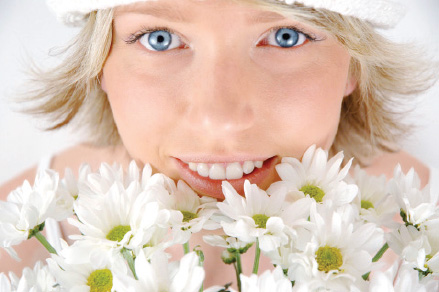
Camomile lightening rinse for blond hair. Gently heat a pot with 1 cup of camomile flowers and 2 cups of boiling water for 30 minutes. Do not bring to a full boil. Set the infusion aside for a few hours, strain and then pour through your hair several times, catching liquid in a bowl. The lightening effect will be increased if you dry your hair in full sunlight and use the rinse regularly. Prepare the infusion in an enamelware pot rather than one of aluminum, and filter out the flowers with a nylon mesh strainer.
Yogurt for dandruff. Yogurt is reported to help even difficult cases of dandruff. Work a liberal quantity into the scalp and hair and leave for an hour before shampooing as usual.
Gelatin as a setting lotion. Gelatin gives lifeless hair added body and weight. Simply dissolve a packet of fruit-flavored jello in a little boiling water and add to your rinse water. Select the flavor that is closest to your natural color. The sugar in the gelatin makes this setting lotion more effective.
Bath preparations
Herbal baths. Add herbs to your bath for their soothing, healing, stimulating, or aromatic properties. Camomile is soothing and cleansing; comfrey has a great reputation as a rejuvenating herb; lovage has deodorant properties; lady's mantle is considered helpful for skin irritation; and lavender, mint, and many others can be added to the bath water for their special aromas. To prepare an herbal bath, either make a strong infusion, strain, and add to the bath water, or tie a muslin bag of mixed dried herbs to the tap as the bath is filling.
Bath oils. Turkey-red oil, a derivative of castor oil, acts as an emulsifying agent for other oils so that they will not coat the skin or bathtub. Mix three parts turkey-red oil with one part of your favorite aromatic oil and add a few drops to your bath.
Milk baths. Cleopatra was famed for maintaining herds of animals that were used exclusively to provide her with fresh milk for her baths. Today, you can easily add a packet of dried milk to create your own softening and soothing bath.
Oatmeal scrubs. Oatmeal makes an excellent nonalkaline soap substitute. Wrap a handful of dry oatmeal in a washcloth, dampen it, and rub it over your body in place of soap when you take a bath or shower. Oatmeal is a soothing, softening cleanser. If your skin is dry, use ground almonds in place of oatmeal; they are particularly moisturizing.
Hand care
Bran water for smoother hands. To make your roughened hands smooth, simply dip them in bran water and dab dry three or four times a day, especially after washing dishes. To prepare bran water, add 1 cup of boiling water to ½ cup of natural bran and allow to steep for 15 minutes before straining the bran out. Leave a small bowl of the water by your sink and keep the remainder refrigerated. You may want to put on a simple moisturizer afterward. Oatmeal is another soothing and nourishing wash useful for irritated or sore hands. First simmer one part of old-fashioned, noninstant oatmeal in two to three parts of water until the meal swells and becomes soft. Then strain into a container and use as bran water.
Honey and almond cream. This traditional recipe makes a very moisturizing night cream for dry hands. Melt 2 oz. of honey in a double boiler and mix in 4 oz. lanolin until thoroughly combined. Remove from heat and allow to cool before stirring in 2 oz. sweet almond oil and a few drops of your favorite perfume.
Toothpastes, breath fresheners, and deodorants
Simple toothpastes. Benjamin Franklin used a mixture of honey and ground charcoal, which is said to leave teeth shining white. Thick pastes of salt or bicarbonate of soda are simple, effective toothpastes. For a smoother blend, combine three parts bicarbonate of soda with one part salt. Then add 3 tsp. of glycerine for every ¼ cup of salt and soda mixture and combine with enough water to make a soft paste. To improve the taste and leave your mouth feeling clean, add several drops of peppermint oil.
For brown stains on the teeth, rub teeth with lemon rind and rinse the mouth thoroughly afterward. One of the pleasantest tooth cleaners is a fresh strawberry; simply rub the fruit against your teeth and into all the cracks.
Breath fresheners. Eating green vegetables, especially parsley and watercress, is helpful for simple breath odor. Use undiluted rose water for a fragrant mouthwash and gargle.
Natural deodorants. Eat plenty of green vegetables, as the chlorophyll they contain is helpful in reducing body odor from perspiration. A simple deodorant can be made from a few drops of lavender oil in a teaspoon of lavender water or plain water. Apply lightly to the freshly washed underarm area. A strong infusion of lovage or sage can be applied to the armpits or added to the bath water. Fresh crushed chrysanthemum or lovage leaves applied gently to the underarm area are additional natural deodorants. Some people use cider vinegar diluted or full strength; the vinegar smell disappears in a few minutes. Note that none of these simple deodorants act as antiperspirants.
Some Practical Formulas For Around the Home
Of necessity, country people used to be amateur chemists, making their own cleansers, glues, inks, polishes, and paints out of common household substances. Some of their concoctions were the products of experimentation; more often they were recipes handed down in the family or community for generations.
Old-time paintmaking methods illustrate the ingenuity of farmers in adapting materials they produced on the farm or could find nearby. As a binder to hold the pigment, they used sour milk, buttermilk, eggs, rice, sugar, linseed oil, or hot freshly slaked lime. Chalk improved covering ability by making the mixture more opaque. Colors were provided by anything from charred potatoes to berries, herbs, barks, and local clays.
Today, many of the old farm and homestead formulas are still useful. Some are the basis of products that are now manufactured, others work as well or better than commercial products, and almost all are less expensive than their hardware store equivalents.
Stain removers
When a stain occurs, act immediately to blot up any staining material not yet absorbed. Gently pat the stained area with a clean absorbent cloth or tissue or else scatter talc, flour, or baking soda on the stain. Be careful not to press the stain further into the fabric. Once the excess stain is removed, proceed with further stain removal. It is helpful to know what caused the stain. There are many substances that must be removed with dry cleaning fluid or other special treatment, and inappropriate action will only make the stain permanent. For stains on suede, velvet, or other sensitive fabrics, consult a professional.
Nongreasy stains on washable fabrics. Soak the material in a mixture of 2 pt. of lukewarm water, ½ tsp. dishwashing liquid, and 1 tbsp. of white vinegar or ammonia. After 15 minutes gently rub and rinse the fabric. If the stain persists, apply vinegar or rubbing alcohol with a clean cloth. Work gently from the center of the spot toward the edges to remove rings, and work at the edge unevenly to disperse the line. This formula is useful for removing stains made by coffee, tea, wine, vinegar, beer, mixed drinks, soft drinks, fruit juices, jellies, and maple syrup.
Wax, oil, and grease spots. Place paper towels or absorbent material on either side of the spot and apply a hot iron. Replace the absorbent material as soon as some of the stain has been absorbed and repeat the process until all the substance has been taken out. If the spot is stubborn, apply slightly diluted ammonia, and iron again as above.
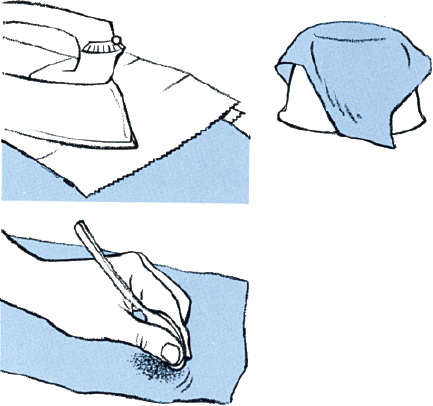
Grease stains can be removed by placing paper towels or absorbent material on both sides of fabric and applying a hot iron (upper left). With stubborn old stains (left) it may help to work the stain with the edge of a spoon. Use the back of a bow for a convenient, stainproof work surface (above).
For ink and ball-point-pen marks. It usually helps to dissolve the spot in warm glycerine, apply absorbent material, and rinse with water. Then use the recipe given for delicate fabrics.
Potato starch for grease spots. Put finely grated raw potatoes into a pot of water. After 15 minutes, strain off the potatoes, allow any remaining particles to settle, and pour the liquid into a bottle. Apply the liquid only to the grease spot, since it may alter the color of the surrounding fabric.
For stains on delicate fabrics. Mix one part glycerine with one part mild dishwashing liquid and eight parts water. Dab the mixture onto the spot, then blot with cloth or tissue, changing it as soon as some of the stain has been extracted.
Metal cleaners
Cleaning copper and brass. Plain tomato juice, catsup, hot vinegar, hot buttermilk, or a mixture of equal parts of salt and vinegar all make effective cleansers for unlacquered brass and copper. For a stubborn tarnish, cut a lemon in half and dip it in a solution of equal parts of salt and vinegar and rub energetically. To make a cleaning paste, heat 10 oz. of liquid soap in a double boiler and add 1 ½ tbsp. each of cream of tartar, jeweler's rouge, and magnesium carbonate, plus 3 tbsp. whiting (finely powdered chalk). Allow the mixture to cool before using it as a polish.
Ornamental copperware that is coated with lacquer should be rinsed in warm soapy water and wiped dry. To remove lacquer, submerge the pot in boiling water. Allow to cool until the lacquer peels off easily.
Removing rust from iron pots and kettles. Fill the kettle with as much hay as it will hold, add water to the brim, and boil for several hours. If some rust remains, repeat the same process.
Cleaning silver and silver plate. Moisten a soft cloth in ammonia, then dab it it in some whiting and polish the silver with it. Another good polish can be made by mixing 2 oz. of soap flakes and 4 oz. of whiting into 2 cups of warm water, then adding 1 ½ tbsp. ammonia when the mixture is cool. Store in an airtight bottle. If you are cleaning silver plate, do not rub too vigorously, since the plating is pure silver, which is softer than sterling silver.
Cleaning aluminum. Aluminum has a relatively porous surface, which stains and darkens easily. To restore a stained pot, immerse the discolored portions in several inches of water, add a few tomatoes or stalks of rhubarb, and bring to a boil. Wiper dry with a soft cloth. Alternatively, boil in a solution of equal parts water and vinegar and wipe dry.
Furniture polishes
Beeswax for wood. Beeswax is one of the best polishes for furniture and floors. It gives a good shine and helps furniture develop an antique patina. Melt down 2 oz. of grated beeswax in a double boiler. Turn off the flame, remove the melted beeswax from the stove, and stir in 2 cups of turpentine. Keep the mixture away from flames; turpentine fumes are highly inflammable. Apply sparingly to furniture and floors and polish energetically.
To brighten unpolished wood furniture. Wipe over with cold tea. This brings out the grain and slightly darkens new wood.
Carpet cleaning
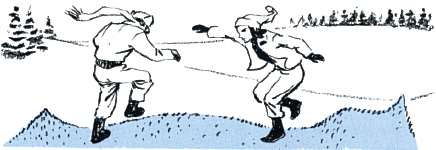
Cleaning a wool rug with snow. For this cleaning method the temperature must be well below freezing and there should be at least 4 in. of clean, dry, fresh powder snow on the ground. Place the rug outside for half an hour to allow any grease particles to solidify, then lay the carpet on the snow and walk or jump back and forth over its entire area. Shake the rug out and repeat the process on the other side. Continue until the rug is clean. The same method can be used for wool blankets. The procedure does not remove the wool's natural oils.
Cleaning a carpet with potatoes. An old recipe for cleaning a dirty carpet recommends scattering grated raw potatoes over it followed by a vigorous brushing with a new broom. The carpet should be beaten or vacuumed thoroughly before putting down the potatoes and again after the job is finished.
Sweeping with tea leaves. If you are sweeping a dusty floor, first sprinkle damp tea leaves, damp bran, or fresh grass cuttings over the floor. They will settle and collect the dust.
Pest destroyers and deterrents
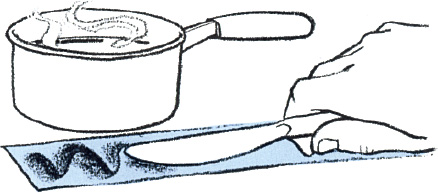
Flypaper. Combine equal parts of melted resin and castor oil, then spread over long strips of stiff writing paper with a knife warmed in a jug of hot water. For ease of handing, do not coat the edges of the paper. Thread string through one end of flypaper and hang the paper near light fixtures or windows. For a saucer of flykiller, mix an egg yolk with 1 tbsp. molasses and 1 tbsp. black pepper. Set it on windowsill or shelf.
Peppermint to discourage mice. Mice are reputed to dislike the smell of fresh peppermint. Grow your own peppermint and leave fresh sprigs wherever you see evidence of mice.
Tansy for moths. Tansy has long been used to keep rooms and food free of insects. To use it as a moth repellent, make sachets containing the crushed dried leaves. Distribute the sachets among clothing and bedding in chests, and hang them in closets.
Feverfew insect repellent. Make an infusion of feverfew by adding 1 oz. of the herb to 2 ½ cups of boiling water. Apply to the skin when cool.
Glues and pastes
Flour paste. Flour and water make an excellent paste for gluing paper and light objects together. This paste is still used in bookbinding and mounting prints. Blend some whole wheat flour with cold water to make a liquid paste and beat until free of lumps, then heat gently to boiling, stirring all the time. Allow to cool before using. If paste hardens before use, it can be softened with water.
Wallpaper paste. Gradually mix cold water with 4 Ib. of white flour to make a stiff paste, beating the mixture until the lumps are removed. Next, add more water until the paste has a creamy consistency; then stir in 2 oz. of powdered alum. Finally, stir vigorously while adding enough boiling water to make about 1 ½ gal. of paste. Allow to cool before using. This paste will keep for several weeks.
White china cement. Make a strong solution of gum arabic by adding only enough water to dissolve it, then add plaster of Paris to produce a stiff paste. Apply to the broken edges of the china. If the china is colored, you can add pigment to match the color or paint the surface when the cement has dried. If applied skillfully, it can make an almost invisible repair. This glue is very strong but is soluble in hot water.
Wood-ash stove putty. T o fill cracks in a cast-iron stove, mix equal parts of fine powdered wood ash, powdered fire clay, and salt; then add enough water to make a paste. Although this mixture dries hard, it still has to be replaced from time to time.
Fireproof cement for cast-iron stoves. Add enough egg white to some hydrated lime to make a paste, then mix in iron filings. Apply to the crack or broken pieces. Allow plenty of time to dry before using the stove. This cement becomes progressively stronger and more durable with repeated heating. Caution: Lime is a highly caustic substance. Rinse skin immediately in the event of contact with skin.
Paints, whitewashes, and inks
Simple black paint from potatoes. Bake several potatoes in a slow oven until they are cooked, then turn the oven to hot and let the potatoes continue cooking until they are completely black and dried out. Grind them up thoroughly in a mortar and pestle, and add enough linseed oil to give a runny consistency. For a durable green paint add yellow ocher.
Old-fashioned milk paint. To make a quart of paint, add 3 tbsp. vinegar to 4 cups of milk and heat gently until the mixture curdles. This creates sour milk. Then mix in 1 oz. of slaked lime. For a long-lasting paint, make sure that your mixture is pH balanced by testing with litmus paper from a pharmacy. If the paper turns red, the mixture is too acid and you should add more lime; if the paper turns dark blue, the mixture is too alkaline and you should add some sour milk. Next, mix in 2 to 2 ½ Ib. of whiting to achieve the proper consistency. Stir thoroughly and slowly sprinkle in some dried pigment. The paint will produce a soft, flat finish suitable for any antique-style wall or furniture decoration. Milk paint is not as durable as modern paint and should be protected with a coat of shellac if used on furniture.
New England glazed whitewash. Boil ¾ Ib. rice and ½ sugar in 7 pt. water until the rice has dissolved. Remove from heat and add 1 pt. raw skimmed milk, then mix in hydrated lime until the consistency is that of thin paint. This whitewash is best applied with a soft-bristled brush. Many other whitewash formulas exist. Almost all are based on slaked (hydrated) lime, and many employ zinc sulfate as the whitening agent. The mixture given here produces a finish with a soft, satiny sheen.
To make your own pigments. Any attractively colored earth can be used. Boil up a few spadefuls in plenty of water for several hours. Strain out the organic matter and stones and allow the sediment to settle. Pour off the water and set the residue to dry in shallow pans. Pound finely in a mortar and sift again before adding to paint. A few companies still supply earth pigments and other natural coloring agents.
To remove the smell of paint. Take a few handfuls of dry hay, the older the better, and immerse it in water. Shake out the excess moisture and set the hay in shallow pans around a freshly painted room. Dampen the hay as soon as it dries out. The moist hay will absorb the oily vapor.
To make Prussian blue ink. Dissolve enough Prussian blue, available as laundry bluing, in water to give the color intensity you want. Prussian blue makes a rich blue ink.
To make permanent black ink. Mix 8 oz. honey with 1 egg yolk and ¼ oz. gum arabic. Then add enough lamp black to give a stiff paste. Yo u can collect your own lamp black on a plate held over a candle flame or buy it in a tube. Store the paste in a jar. For use, mix a little paste in just enough water to make a fluid.
To make brown ink. For an easy to make brown ink, simply add ½ cup boiling water to four tea bags or 4 tsp. of loose tea. Steep for 15 minutes and stir to extract as much tannic acid as possible. Strain and allow to cool before bottling.
Sources and resources
Books and pamphlets
Botchis, Lilli. Plants in the Light of Healing. Fairfield, Iowa: Time Portal, 1995.
Buchman, Dian D. Herbal Medicine: The Natural Way to Get Well and Stay Well. New York: David McKay, 1979.
Coon, Nelson. Using Wild and Wayside Plants. New York: Dover, 1980.
Decorso, Dorothy. Herbal Health. Cincinnati, Ohio: Seven Hills Books, 1995.
Evelyn, Nancy. The Herbal Medicine Chest. Trumansburg, N.Y.: The Crossing Press, 1986.
Fettner, Ann Tucker. Potpourri, Incense and Other Fragrant Concoctions. New York: Workman Publishing Co., 1977.
Genders, Roy. Growing Herbs as Aromatics. New Canaan, Conn.: Keats Publishing, 1977.
Hayes, Elizabeth. Spices and Herbs: Their Lore and Use. New York: Dover, 1980.
Jacka, Judy. A-Z of Natural Therapies. Cincinnati, Ohio: Seven Hills Books, 1995.
Jarvis, D.C. Folk Medicine. New York: Fawcett Book Group, 1985.
LeArta, Moulton. Nature's Medicine Chest. Provo, Utah: Nature's Medicine Chest, 1990.
Ley, Beth. Natural Healing Handbook: Get Back to Health . . . Naturally. Newport Beach, Calif.: BL Publications, 1994.
Lust, Benedict. About Herbs: Nature's Medicine. Greenwich, Conn.: Benedict Lust Publications, 1983.
Mayer, J.E. The Herbalist. New York: Gordon Press, 1992.
Rose, Jeanne. Herbs and Things. New York: Grosset & Dunlap, 1972.
Schar, Douglas. The Backyard Medicine Chest: A Herbal Primer. Washington, D.C.: Elliott & Clark, 1995.
Periodicals
Prevention. Rodale Press, Inc., 33 East Minor St., Emmaus, Pa. 18049.
Suppliers of herbs and potpourri ingredients
Caswell-Massey Co., Ltd. (Mail Order Department). 111 Eighth Ave., New York, N.Y. 10011.
Indiana Botanic Gardens, Inc. 3401 W. 37th Ave., Hobart, Ind. 46342.
Kiehl's Pharmacy, Inc. 109 Third Ave., New York, N.Y. 10003. Nichol's Garden Nursery. 1190 Old Salem Rd. NE, Albany, Oreg. 97321. Pickity Place. Box 303, Nutting Hill Rd., Greenville, N.H. 03048.
Suppliers of pigment for paint
Johnson Paint Company. 355 Newbury St., Boston, Mass. 02215.